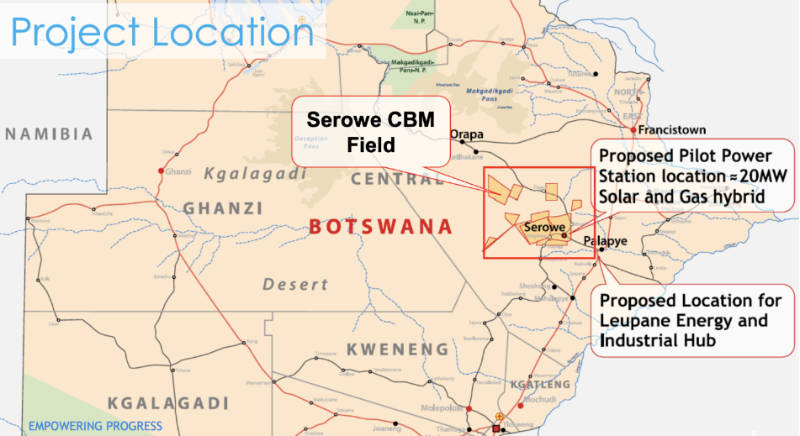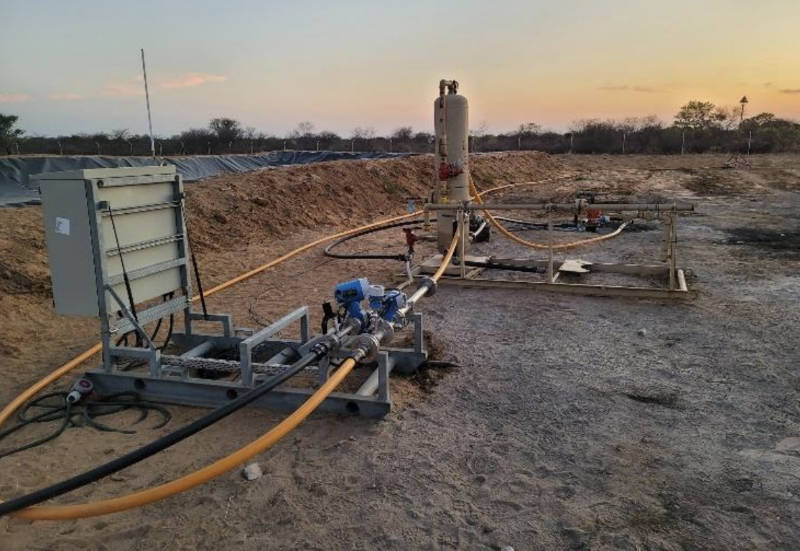Botala’s hearty Botswana gas and energy offering comes with a healthy social, environmental side

Botala’s tasty projects like Serowe and the hybrid power plant will seek to benefit local stakeholders. Pic: via Getty Images
Energy companies are not typically known to be paragons for social and environmental consciousness, yet that is exactly what Botala Energy would like to be known for as it progresses its operations in Botswana.
The company, which is progressing a number of energy initiatives including the Serowe coal bed methane (CBM) project, a hybrid solar and gas pilot power station, and solar panel manufacturing, is keen to do good by local stakeholders.
Speaking to Stockhead, chief executive officer Kris Martinick said Botala Energy (ASX:BTE) is an energy company with a social conscience.
“It’s not our gas, it’s Botswana’s gas and they need to see the benefits from it,” he noted.
“Obviously we have shareholders to look after, but we also have to look after the people whose gas it is.
“We’ve always had a very strong drive towards making sure that we do the right thing by the local stakeholders and so we’ve always had good stakeholder engagement, which is incredibly crucial to these projects.
“Many of these projects, you can always find the rocks or the engineering solutions, but finding a solution to the hearts and minds and the stakeholder engagement is often the reason why a project is delayed or even stopped.”
He pointed out that Botswana had huge unemployment and a serious need for both food and fuel with people experiencing health problems from burning wood or even plastic when they run out of wood.
Botswana’s energy issues are not helped by Eskom’s failure to provide affordable and reliable power, which has serious implications as the South African public utility is the largest producer of electricity in both Africa and the Southern African Power Pool.
Energy is also where Botala expects to be able to make a difference – at least in Botswana – with Martinick confident that the company will prove its social licence to operate over the next 6-12 months though he also highlighted its work with the local orphanage and was looking to minimise the loss of water produced by its operations by starting market gardens.
Experienced and well credentialled board
This same licence to operate extends to the company’s board with Martinick’s father Dr Wolf Martinick – an environmental scientist with over 40 years’ of experience – serving as the executive chairman with a focus on stakeholder engagement and the company’s environmental impact assessments.
“He spent a number of years in Africa and has done a lot of African projects, but his real expertise comes from his environmental consulting days,” the younger Martinick noted.
“He provides a wealth of knowledge on how to do environmental impact assessments, manage the environment clearance you know, clearing and rehabilitation. We do clearing and rehabilitation, we rehabilitate as soon as we can. We’re not mandated to do that, but we do that.”
Martinick added that the company had its employees and directors out in the field rather than consultants.
“If a farmer has a concern, they are talking directly to the management so they can see that a decision can be made straight away.”
Other Board members include chief financial officer and company secretary Craig Basson, who plays a crucial role working with the ASX and financial stakeholders along with non-executive director Peter Grant who provides the company with geological input.
“Grant has years of experience with Woodside, BHP working in Africa and has really become a bit of a figure of support for the geologists that we have in country,” Martinick highlighted.
“Part of his remit – even though he’s a non-executive director – is helping with training programs for our geologists and making sure that they’re skilled as well as providing oversight of the geology.
“His background is very strong in geophysics and we’ve been planning on how we can apply purpose specific geophysics in the area to better determine optimal well locations that avoid dolerite intrusions and intersect the thickest coal seams. Recent results appear to vindicate the work.”
Adding further expertise to its executive team is Dr Stephen Lennon, who has over 30 years’ experience with Eskom at a time when it was one of the world’s top performing power companies.
“He brings expertise gained across his long career of leadership within the energy industry, sustainability, technological innovation and management fields,” Martinick explained.
“His experience with Eskom gives him a unique understanding of southern Africa’s power generation and distribution infrastructure and services and the complexity of the engineering, financial, political, and social challenges.
“At Botala, in addition to his contributions to strategy, and investor engagements, Steve is managing the development of the gas and solar power projects and driving the processes aimed at securing grid access and markets for the energy.”
Martinick himself cut his teeth working in Papua New Guinea – mainly for Oil Search – giving him plenty of experience with projects in very difficult environments.
“I’m well accustomed to working in tough regions, hard logistic supply chains, issues with orders, etc. That applies very well to Botswana,” he added.
“The last project that I worked on was a 50MW power station in Port Moresby, next to the PNG LNG plant site.”

Energy in Botswana
However, the focus on being a social and environmental champion as well as having an experienced and credentialed board will be for naught without at least one strong project to anchor things.
And Botala Energy has built a three-pronged strategy that is centred – at least in the early stages – around the Serowe CBM project that it first farmed into in 2020 and has since moved to 70% ownership.
The company has kept a constant pace of activity at Serowe, adding six wells to the single well drilled by the previous operator, and is currently focused on proving the project’s ability to flow gas commercially.
Serowe currently has a certified best estimate (2C) Contingent Resource of 317 billion cubic feet of gas, which is enough to fuel Botswana’s existing power station for about 20 years, but this is still at early stage given the certification is based on just five of the seven wells drilled to date and even those wells cover just a small portion of the project.

Other benefits include the low cost of labour and drilling, with Martinick noting that a well can be drilled and completed for between $200,000 and $220,000 while a comparable well in Australia would cost between $700,000 and $1m.
This is thanks in no small part to the relative shallow Serowe coal seam, which tends to be gaseous compared to the deeper coals drilled by its neighbours which tend to be undersaturated and full of water.
“So, we don’t need as much gas or coal as we extract it at a lower cost of production,” he added.
“It is about defining the pathway that is going to work and working out the right recipe to get it out of the ground.”
“We’ve started flowing gas from Serowe-3 and it is starting to build up pressure and has given us enough confidence to go and proceed with four additional wells around that area to drain a bigger area of water and create what we’d see as the commercial pilot program.”
He noted that the company saw three ways to commercialise the gas, first selling it to the Botswana Power Corporation before the gas eventually wheels through the entire grid and can be sold within the SAPP, which opens up gas sales to potential off takers from Cape Town to the Democratic Republic of the Congo.
The third option is to sell gas within the company’s own boundaries, which neatly segues into the other two prongs of its strategy.
Hybrid power generation
Martinick explained that the company always had the vision to target the energy transition by first developing Serowe and then commercialising it with a 20-megawatt solar gas hybrid system near Serowe town, which not only reduces CO2 emissions but reduces the cost of electricity produced when the sun is shining.
“It’s really the only way at this time to develop a dispatchable energy system as batteries are currently too expensive, so you need the gas to generate power when there’s no sun,” he noted.
Success will be the proof of concept that allows Botala to progress developing or taking a part in larger hybrid systems.
The third leg of the company’s strategy is to enter the solar panel manufacturing business.
“Solar panel manufacturing is a really attractive business to us because of several factors,” Martinick said.
“Last year was the first year where solar panels actually went up in price after the surplus and demand changed.
“Everyone wants high quality panels but they don’t necessarily want the tier one panels that are coming out of China and Korea these days. They want to diversify away from that.”
He noted that the company’s plan to produce solar panels has opened the door to talks with international funds, to Finfunds and green funds, which in turn gives Botala an avenue to talk more about its bigger project ideas.
Support from the Botswana Government has also been strong, leading to the award of a special economic zone with huge tax benefits for the project.
“We do not want to be the outright owner though we are going to own a portion of it,” Martinick added.
“Our role has been doing the project development, the environmental assessments and really driving it on our location and we would like to have a slice of it because it’s a great business.
“At the moment we are pretty confident that we are going to get some binding term sheets. Solar Finland are on board, we have expressions of interest from two others – one we are certain will convert to a formal term sheet in the coming weeks.”
That the solar manufacturing plant will be located at the company’s planned 1,520ha Leupane Energy Hub & Industrial Park also presents a fantastic opportunity for the company to attract users to the hub where it can offer them gas and/or electricity.
“That’s the long term pitch, but we still have to focus heavily on getting the gas out of the ground and getting it appraised, then ideally getting it into this 20MW power station as our proof of concept,” Martinick concluded.
This article was developed in collaboration with Botala Energy, a Stockhead advertiser at the time of publishing.
This article does not constitute financial product advice. You should consider obtaining independent advice before making any financial decisions.
Related Topics

UNLOCK INSIGHTS
Discover the untold stories of emerging ASX stocks.
Daily news and expert analysis, it's free to subscribe.
By proceeding, you confirm you understand that we handle personal information in accordance with our Privacy Policy.








